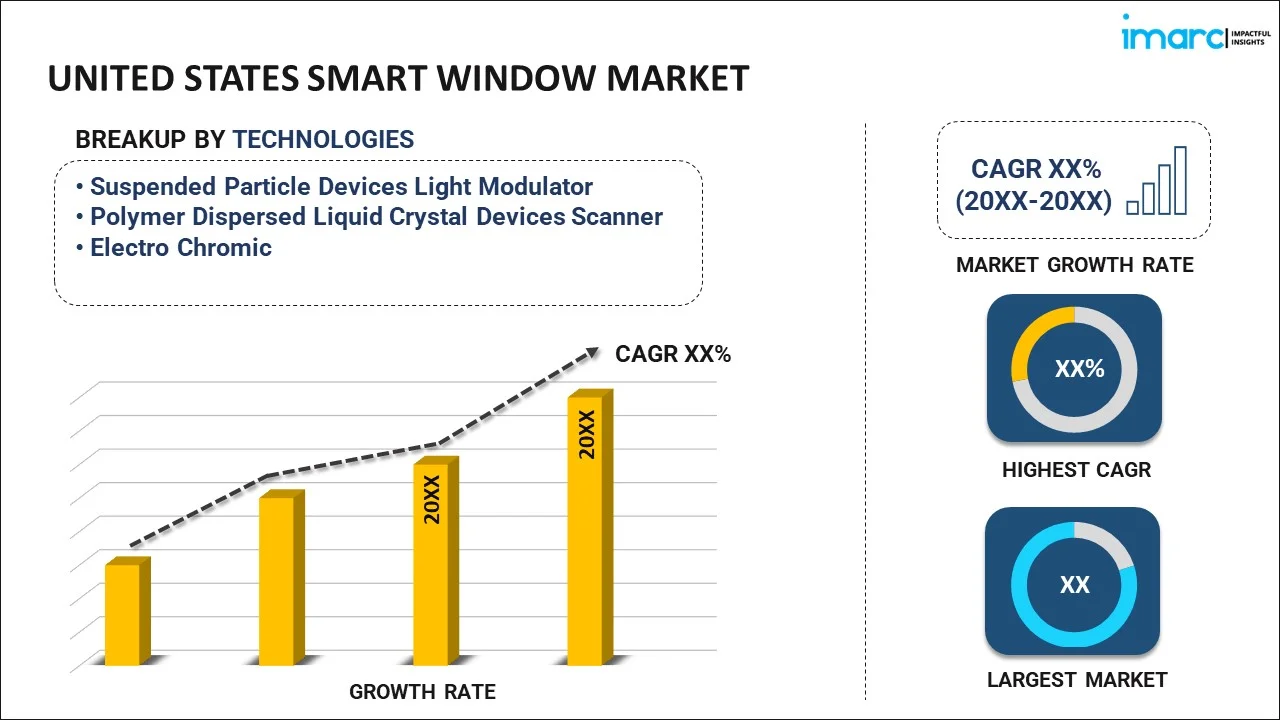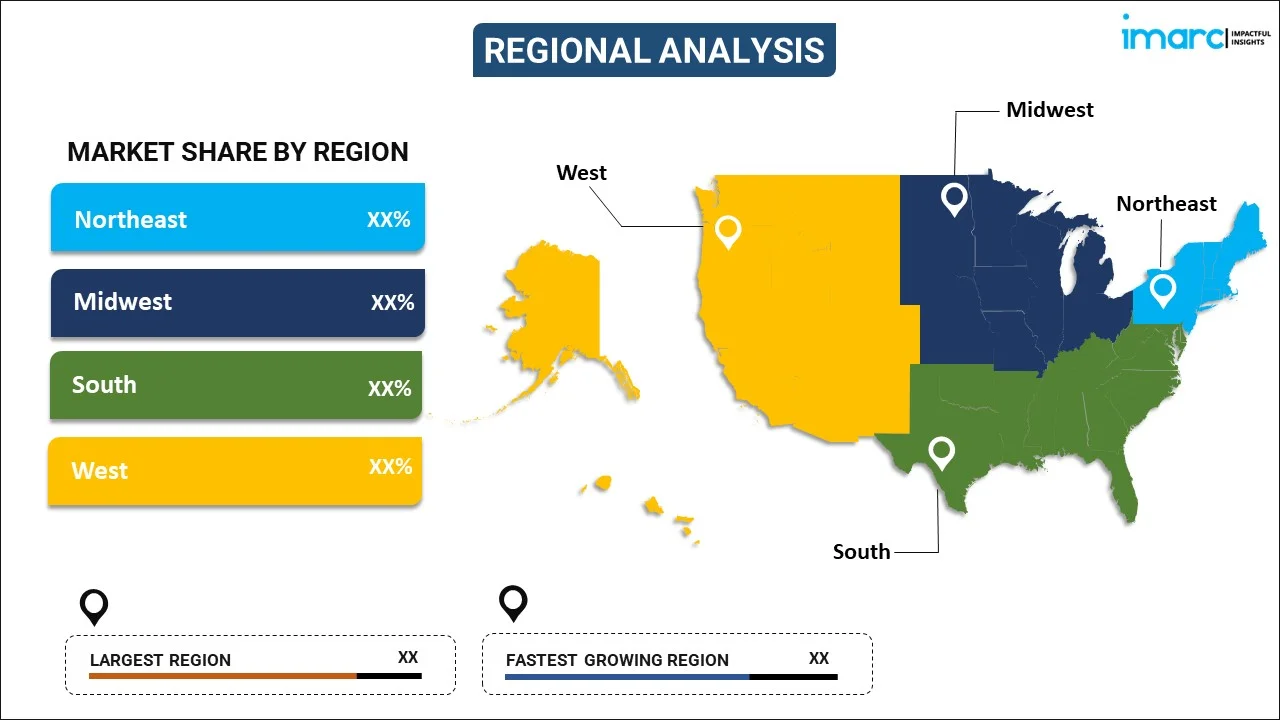
United States Smart Window Market Report by Technology (Suspended Particle Devices Light Modulator, Polymer Dispersed Liquid Crystal Devices Scanner, Electro Chromic), Type (OLED Glass, Self-Dimming Window, Self-Repairing), Application (Residential, Commercial, Industrial, Transport), and Region 2025-2033
United States Smart Window Market Size, Share & Analysis:
The United States smart window market size reached USD 2.1 Billion in 2024. Looking forward, IMARC Group expects the market to reach USD 5.1 Billion by 2033, exhibiting a growth rate (CAGR) of 9.70% during 2025-2033. The market is propelled by the intensifying focus on energy efficiency, sustainability, and smart building solutions. Drivers include developments in electrochromic technologies, Internet of Things (IoT) integration, and enabling environmental regulations. However, challenges related to high capital expenses, retrofit complexity, and limited consumer awareness exist. These drivers will have to be managed by innovation, strategic investment, and stakeholder education. All such initiatives are anticipated to make significant contributions towards the growth of the United States smart window market share.
|
Report Attribute
|
Key Statistics
|
|---|---|
|
Base Year
|
2024 |
|
Forecast Years
|
2025-2033
|
|
Historical Years
|
2019-2024
|
| Market Size in 2024 | USD 2.1 Billion |
| Market Forecast in 2033 | USD 5.1 Billion |
| Market Growth Rate (2025-2033) | 9.70% |
United States Smart Window Market Trends:
Integration with Smart Home Ecosystems
Smart window integration into more extensive smart home ecosystems is having a revolutionary impact on residential and commercial spaces nationwide. With homes and buildings embracing intelligent control systems, smart windows are being more closely tied with voice assistants, energy monitoring systems, and centralized automation networks. With such integration, users can control light, glare, and heat by voice or smartphone commands. This capability is in line with changing United States smart window market requirements, including customization, automation, and energy optimization. Increased integration of adaptive glazing technologies further propels the overall United States smart window market growth, as consumers are drawn towards convenience and environmental savings. This trend also underlies the increasing market share, with easy interoperability among smart thermostats and lighting systems further increasing their practicality. As smart homes gain popularity in urban and suburban developments, these solutions play a pivotal role in the United States smart window market forecast and technological innovation.
Energy-Efficient Building Standards Driving Adoption
The trend towards building in an environmentally friendly manner is driving the adoption of dynamic glazing technologies across the nation. Smart windows, and the capacity for modulating solar heat gain and daylight penetration, are increasingly integral to sustainable building practices. Being in harmony with green efforts and stricter regulations, its role in fueling the United States smart window market size growth is critical. Innovations like electrochromic and thermochromic glazing, which self-modulate according to ambient conditions, are particularly significant in minimizing dependency on HVAC systems. These technological innovations are influencing major United States smart window trends and fueling adoption across industries seeking LEED and other green certification. As per the sources, in January 2025, Gauzy introduced its very first black Suspended Particle Device (SPD) Smart Glass at CES 2025, providing a darker look for automotive, aerospace, and architectural applications. The innovation advances visual and thermal comfort and is a significant U.S. premier in smart glass technology and energy-efficient light control. In addition, retrofit potential in existing infrastructure—especially among schools, municipal buildings, and federal facilities—clearly supports the need for future innovation. The United States smart window market forecast will highlight the critical role of public policy intersecting with architectural innovation, as sustainability-focused states lead the push for energy-efficient infrastructure, setting benchmarks that influence nationwide adoption.
Growth in Commercial Real Estate Applications
The commercial real estate industry is increasingly seeing the strategic and economic benefit of smart window solutions. High-performance glazing is being installed throughout office campuses, hospitals, airports, and hospitality facilities to cut energy loads and enhance occupant comfort. This momentum serves to fuel deeper United States smart window market analysis, with evident congruence between smart infrastructure and modernization of real estate. Developers are drawn to the potential for operational cost savings and improved indoor environmental quality, both of which serve as a primary means of attracting long-term tenants. Their use in skyscrapers and mega-format buildings, where solar exposure management is paramount, also speaks to changing market needs. In addition, their sleek look complements current architectural trends. As ecologically aware companies demand creative workplaces, smart windows are seen as high-end amenities, helping positively shape the United States smart window market outlook and propelling the country's path toward intelligent, efficient infrastructure.
United States Smart Window Market Opportunities:
The market offers huge opportunities fueled by increasing United States smart window market demand for energy-efficient building technology. With commercial and residential property developers focusing more on sustainability, smart windows are a compelling answer by cutting down on artificial lighting and HVAC system usage. Breakthroughs in electrochromic and thermochromic glass technology add to the sheen, enabling windows to regulate tint according to outside conditions, enhancing occupant comfort, and lowering operating expenses. Government incentives and green building ratings also encourage adoption, especially in urban infrastructure construction and retrofitting. In addition, smart windows are increasingly part of the design of smart homes and offices as part of overall trends in automation and networked systems. As indoor environmental quality awareness grows, these advanced windows can enhance natural light control and thermal management, and thus are suitable for use in hospitals, schools, and office buildings. The convergence of IoT and AI in window systems offers yet another frontier, allowing for smart energy management solutions.
United States Smart Window Market Challenges:
The United States smart window industry, though promising, has a number of considered challenges that can potentially affect its wider adoption. The relatively high initial cost of smart window technologies, as opposed to conventional ones, is one such consideration that can keep cost-conscious consumers or smaller enterprises away. Moreover, the embedding of smart window systems within existing building structures will involve specialized retrofitting, which can complicate projects and extend lead times. End users also need further education on the long-term advantages of smart windows because there are still misconceptions about how they work and their durability. In addition, integration with many different smart building platforms and ensuring error-free performance in a wide range of climates are areas needing constant innovation and testing. Finally, creation of standardized policies and industry standards must be undertaken in order to facilitate consistent quality and safety across all products. Tackling these issues with transparency and education can help build greater confidence and easier market expansion in the long term.
Key Market Segmentation:
IMARC Group provides an analysis of the key trends in each sub-segment of the United States smart window market report, along with forecasts at the country and regional level from 2025-2033. Our report has categorized the market based on technology, type and application.
Breakup by Technology:

- Suspended Particle Devices Light Modulator
- Polymer Dispersed Liquid Crystal Devices Scanner
- Electro Chromic
Breakup by Type:
- OLED Glass
- Self-Dimming Window
- Self-Repairing
Breakup by Application:
- Residential
- Commercial
- Industrial
- Transport
Breakup by Region:

- Northeast
- Midwest
- South
- West
Competitive Landscape:
The competitive landscape of the industry has also been examined along with the profiles of the key players.
Latest News and Developments:
- In August 2024, AeroShield Materials launched a 12,000 sq. ft. facility in Waltham, Massachusetts, to produce transparent aerogel sheets to be used in energy-efficient windows. With $5 million in funding, the launch is a significant breakthrough in thermal insulation technology and bolsters innovation in the United States smart window sector.
- In February 2024, Marvin launched Marvin Connected Home™, a new series of automated skylights, windows, and doors for integration with smart home technology. With programmable controls, voice recognition, and embedded sensors for air quality and rain, the introduction reimagines convenience and comfort in contemporary home living.
Report Coverage:
| Report Features | Details |
|---|---|
| Base Year of the Analysis | 2024 |
| Historical Period | 2019-2024 |
| Forecast Period | 2025-2033 |
| Units | Billion USD |
| Technologies Covered | Suspended Particle Devices Light Modulator, Polymer Dispersed Liquid Crystal Devices Scanner, Electro Chromic |
| Types Covered | OLED Glass, Self-Dimming Window, Self-Repairing |
| Applications Covered | Residential, Commercial, Industrial, Transport |
| Regions Covered | Northeast, Midwest, South, West |
| Customization Scope | 10% Free Customization |
| Post-Sale Analyst Support | 10-12 Weeks |
| Delivery Format | PDF and Excel through Email (We can also provide the editable version of the report in PPT/Word format on special request) |
Key Questions Answered in This Report
The smart window market in the United States was valued at USD 2.1 Billion in 2024.
The United States smart window market is projected to exhibit a CAGR of 9.70% during 2025-2033, reaching a value of USD 5.1 Billion by 2033.
Key drivers of the United States smart window market are increasing demand for energy-efficient building solutions, integration into smart home systems, and increasing adoption in commercial real estate. Developments in dynamic glazing, complemented by favorable green building regulations and enhanced awareness of indoor environmental quality, are fueling the movement toward intelligent, automated, and sustainable window solutions across industries.
Need more help?
- Speak to our experienced analysts for insights on the current market scenarios.
- Include additional segments and countries to customize the report as per your requirement.
- Gain an unparalleled competitive advantage in your domain by understanding how to utilize the report and positively impacting your operations and revenue.
- For further assistance, please connect with our analysts.
 Request Customization
Request Customization
 Speak to an Analyst
Speak to an Analyst
 Request Brochure
Request Brochure
 Inquire Before Buying
Inquire Before Buying




.webp)




.webp)












